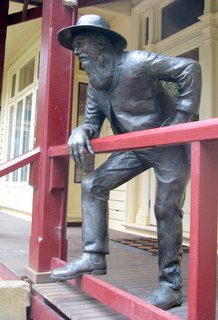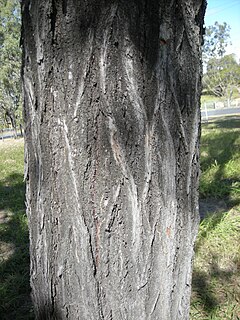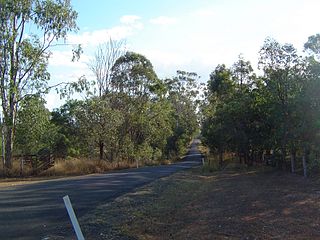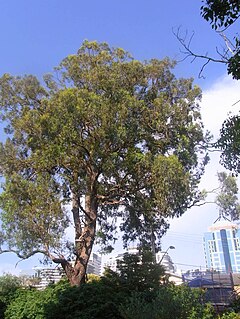
The Chiltern-Mt Pilot National Park is a national park that is located in the Hume region of Victoria, Australia. The 21,650-hectare (53,500-acre) national park is situated approximately 275 kilometres (171 mi) northeast of Melbourne, and extends west from Beechworth across the Hume Freeway and the Albury-Melbourne railway line to the west of Chiltern.

The Heathcote-Graytown National Park is a national park located in the North Central region of Victoria, Australia. The 12,833-hectare (31,710-acre) national park, which includes sections of the Great Dividing Range, adjoins a number of state forests, including the McIvor Ranges State Forest and is located just outside the town of Heathcote.

"The Man From Ironbark" is a poem by Australian bush poet Banjo Paterson. It is written in the iambic heptameter.

Eucalyptus sideroxylon, commonly known as mugga ironbark, or red ironbark is a small to medium-sized tree that is endemic to eastern Australia. It has dark, deeply furrowed ironbark, lance-shaped adult leaves, flower buds in groups of seven, white, red, pink or creamy yellow flowers and cup-shaped to shortened spherical fruit.

Ironbark is a common name of a number of species in three taxonomic groups within the genus Eucalyptus that have dark, deeply furrowed bark.

Eucalyptus crebra, commonly known as the narrow-leaved ironbark, narrow-leaved red ironbark or simply ironbark, and as muggago in the indigenous Dharawal language, is a species of small to medium-sized tree endemic to eastern Australia. It has hard, rough "ironbark" from its trunk to small branches, linear to lance-shaped adult leaves, flower buds in groups of seven, nine or eleven, white flowers and cup-shaped, barrel-shaped or hemispherical fruit. A variable species, it grows in woodland and forest from the Cape York Peninsula to near Sydney. It is an important source of nectar in the honey industry and its hard, strong timber is used in construction.

Eucalyptus fibrosa, commonly known as the red ironbark, broad-leaved red ironbark or broad-leaved red ironbark, is a species of medium-sized to tall tree endemic to eastern Australia. It has grey to black ironbark, lance-shaped to egg-shaped adult leaves, flower buds in groups of between seven and eleven, white flowers and conical fruit.

Stuart Town, formerly known as Ironbark, is a small town on the Central Western Slopes of New South Wales, Australia within Dubbo Regional Council. It is located 317 kilometres (197 mi) north-west of the state capital, Sydney. At the 2011 census, Stuart Town had a population of 487. The area around the town is rich in cattle farming and orchards, so the town serves as a service centre to that area.

The Sydney Turpentine-Ironbark Forest (STIF) is one of six main indigenous forest communities of Sydney, New South Wales, Australia, that is typically in the Inner West region of Sydney. It is also among the three of these plant communities which have been classified as Endangered, under the New South Wales government's Threatened Species Conservation Act 1995, with only around 0.5% of its original pre-settlement range remaining. As of 26 August 2005, the Australian Government reclassified Sydney Turpentine-Ironbark Forest as a "Critically Endangered Ecological Community", under the Commonwealth's Environment Protection and Biodiversity Conservation Act 1999.

Warby Range State Park was a Victorian state park just north of Glenrowan. In 2010 the park became part of the newly declared Warby-Ovens National Park. It is 11,460 hectares in area, and named after Ben Warby, a pastoralist who settled in the area in 1844. There are two basic campgrounds, and many other sites for true bush camping.

Ironbark is a rural locality in the City of Ipswich, Queensland, Australia. In the 2016 census, Ironbark had a population of 604 people.
Coxs Creek, a watercourse of the Cooks River catchment, is located in the Inner West of Sydney, in New South Wales, Australia.

Eucalyptus paniculata, commonly known as grey ironbark, is a species of tree that is endemic to New South Wales. It has dark-coloured, deeply furrowed ironbark on the trunk and branches, lance-shaped to curved adult leaves, flower buds in groups of seven on a branched peduncle, white flowers and conical, hemispherical or cup-shaped fruit.

Reef Hills State Park is a protected area of 2013 hectares, about 5 km south-west of Benalla, in the north east of Victoria, Australia. There are traces of a mining activity from the gold rush. It was established in 1986.

Box–ironbark forest is a forest or woodland ecosystem that is largely limited to central Victoria in south-eastern Australia. Because its component tree species produce abundant nectar and pollen throughout the year, it is important for the conservation of many species of birds and other animals.
The Cooks River/Castlereagh Ironbark Forest (CRCIF) is a 1,101-hectare (2,721-acre) area of dry sclerophyll open-forest to low woodland which occurs predominantly in the Cumberland subregion of the Sydney basin bioregion, between Castlereagh and Holsworthy, as well as around the headwaters of the Cooks River. The majority of the community is found in the north-west section of the Cumberland Subregion in the Castlereagh area between Penrith and Richmond. Other significant patches occur in the Kemps Creek and Holsworthy areas. Smaller remnants occur in the eastern section of the Cumberland Subregion.

Ironbark is a suburb of the regional city of Bendigo in north central Victoria, Australia, 2 kilometres (1.2 mi) north west of the Bendigo city centre. Ironbark was named after the Ironbark Valley. Ironbark was part of Long Gully until 1999 when it a separate suburb.

The Courier is a 2020 historical drama film directed by Dominic Cooke. The film stars Benedict Cumberbatch alongside Rachel Brosnahan, Jessie Buckley, Merab Ninidze, and Angus Wright.

Wallumatta Nature Reserve, also called the Macquarie Hospital Bushland, is a 6-hectare (15-acre) nature reserve bushland area, surrounded by the residential suburb of East Ryde, in suburban Sydney, Australia. Once part of the Field of Mars of 1804, the reserve is the largest surviving area of Sydney Turpentine-Ironbark Forest, an endangered ecosystem. Soils are based on Ashfield Shale and Hawkesbury Sandstone.















